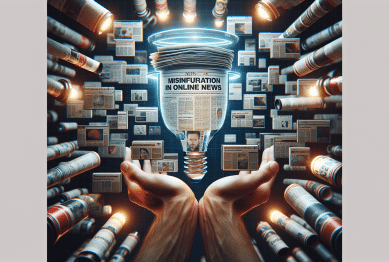Curious about artificial intelligence and journalism? Learn how new technologies are transforming newsrooms, reshaping fact checking, and personalizing news delivery. Understand the opportunities and challenges in media that everyone is discussing.
AI in Modern Newsrooms: From Algorithms to Article Creation
Artificial intelligence is transforming journalism in ways that would have sounded like science fiction only a decade ago. Newsrooms are now integrating machine learning tools for quick data analysis, rapid news gathering, and even automated article creation. For example, major news organizations use AI-driven systems to scan breaking news events, identify trends, and draft straightforward reports. This process allows journalists to focus on more nuanced storytelling and investigative work. Incorporating automation doesn’t just boost productivity — it reshapes how news stories come to life, leaving more energy and creativity for human writers. And as news outlets seek to reach wider audiences, the use of AI-driven platforms in content generation is only growing. This shift influences not just what news is produced but how quickly it’s delivered and how closely it matches what people want to read.
But artificial intelligence isn’t just about producing text; it’s also deeply involved in news curation and distribution. News aggregators and search engines rely heavily on algorithms to select which headlines surface on homepages or notifications. The implications strike at the heart of the reader experience, with algorithms tailoring news feeds to individual preferences and prior reading habits. While this offers convenience and the chance to discover personalized content, it also raises questions about filter bubbles and the diversity of perspectives shown to the audience. Media organizations must balance the benefits of these systems with an ongoing commitment to editorial integrity, ensuring coverage remains broad, fair, and accurate.
This technological leap comes with a learning curve for seasoned journalists and newcomers alike. Training on new platforms, adapting to unfamiliar software, and evaluating the impact of AI-generated content on editorial standards are all part of the daily challenge. Ethical concerns arise, especially where automated writing tools may introduce errors, miss context, or oversimplify complex issues. Readers are beginning to ask: ‘Was this article written by a person or a machine?’ Transparency in news production is more important than ever, as trust remains a cornerstone of journalism (Source: https://www.journalism.org/2023/01/12/ai-in-the-newsroom/).
The Evolution of Fact Checking: How AI Battles Misinformation
Catching errors or outright falsehoods swiftly is at the core of modern news credibility. Artificial intelligence has emerged as a powerful partner in rooting out misinformation. By analyzing the spread of stories on social media, AI can flag suspicious patterns, check facts against trusted databases, and even identify manipulated images or videos. As disinformation campaigns get more sophisticated, so do fact-checking tools — evolving to keep pace with the challenges in digital journalism. Fact-checking is no longer just a post-publication process; it can happen in real time. This rapid response closes the gap between rumor and verified truth, giving readers more confidence in the articles they consume. Many high-profile media outlets now openly discuss the AI-driven methods behind their fact-checking functions, as audience demand for accuracy grows (Source: https://firstdraftnews.org/latest/fact-checking-newsrooms-ai/).
Automated fact-checking doesn’t work in isolation. Human journalists remain essential for providing context, analyzing nuance, and making judgment calls that an algorithm can’t always process. AI systems tend to flag potential errors, highlight questionable claims, or even rank the credibility of sources, leaving human editors to confirm, clarify, or reject those suggestions. This collaboration strengthens newsroom efficiency and raises the overall standard of published material. However, one of the challenges is ensuring these AI systems don’t introduce their own biases or miss cultural or contextual subtleties — a critical aspect as newsrooms strive for fairness and balance (Source: https://www.niemanlab.org/2021/07/ai-and-fact-checking/).
AI-powered tools are expanding the reach of fact checking well beyond major publications, enabling smaller outlets and even independent journalists to vet stories quickly and accurately. Digital tools have democratized access to trustworthy news, potentially leveling the information playing field. Yet, as these systems spread, the responsibilities of users also grow. Media literacy now involves not just knowing how to spot fake news but also understanding the capabilities and limits of AI-driven verification. Readers interested in following how newsrooms tackle misinformation can explore resources that track advances in both detection and prevention (Source: https://www.poynter.org/fact-checking/2022/how-ai-is-helping-journalists-fight-disinformation/).
Personalized News Feeds: The Promise and the Paradox
Personalized news delivery uses algorithms to leverage user data — like search history, click patterns, and engagement time — for a more tailored reading experience. The promise is clear: readers enjoy content that aligns with their interests, needs, and even their moods. Encouraged by higher engagement, news agencies use AI-based systems to curate daily digests, push notifications, and homepages filled with stories that match each account’s consumption habits. This individualization feels like a breakthrough for convenience and depth, as readers spend less time searching and more time reading articles they care about (Source: https://www.towcenter.org/research/personalizing-news).
This convenience, however, comes at a price. The same algorithms that delight users may also limit the diversity of content shown — creating so-called ‘filter bubbles.’ As the AI narrows in on favorite topics or perspectives, it risks shielding readers from important but differing views. This effect has sparked debate in journalistic circles about the responsibility of media outlets to provide a broad spectrum of news, not just what matches prior behavior. Strategies for combating filter bubbles include mixing algorithmic recommendations with editor-curated or even randomly rotated articles, creating space for discovery and surprise.
The paradox is clear: the more a system tries to please, the more it might isolate. Several research institutes have investigated the social implications of algorithmic news curation, urging both transparency and ongoing evaluation. Readers curious about managing their own news diets can explore built-in features for customizing feeds, bookmarking unfamiliar sources, or seeking out reports from different regions and backgrounds. AI can help broaden—or shrink—news perspectives, depending on how thoughtfully these systems are designed (Source: https://www.pewresearch.org/journalism/2022/01/12/news-filter-bubbles-algorithms/).
The Role of Human Reporters in the Age of Artificial Intelligence
Even amidst technological marvels, the heart of journalism remains human. Reporters bring empathy, critical analysis, and ethical considerations that machines are yet to replicate. Investigative journalism in particular requires relationship-building, creative questioning, and contextual awareness. While AI speeds up repetitive or data-heavy tasks, journalists shape the depth, tone, and direction of stories. Many newsrooms are doubling down on human skills by retraining staff to leverage AI tools effectively, without ceding editorial control. This collaboration is about balance — making the most of AI’s strengths, while reinforcing the unique expertise of experienced journalists.
One area where creativity reigns is in storytelling. Long-form features, opinion columns, or cultural analysis benefit from the nuanced choices only a person can make. AI can provide research, offer structure, and identify trends, but it doesn’t replace the intuition, curiosity, or skepticism of a seasoned reporter. News organizations highlight their commitment to human oversight by publishing policies on AI usage and encouraging transparency about which articles use automation. While news readers are increasingly comfortable with AI-assisted formats, trust in journalism as a profession is preserved by upholding strong editorial standards and emphasizing personal accountability (Source: https://reutersinstitute.politics.ox.ac.uk/risj-review/impact-ai-newsrooms).
For younger journalists, the integration of AI represents both opportunity and uncertainty. Training includes not only using technology but also understanding its ethical implications and potential pitfalls. Universities and professional bodies now offer programs focusing on the intersection of artificial intelligence and journalism, preparing the next wave of reporters to navigate this evolving landscape. Adaptability will be a defining trait in years to come. Readers interested in the human-AI collaboration in news can find ongoing discussions in journalism review publications and within digital media forums (Source: https://www.cjr.org/tow_center_reports/ai-reporters-newsrooms.php).
Ethical Dilemmas and the Need for Transparent AI in News
Ethics matter deeply when deploying AI in newsrooms. The rise of generative text, deepfakes, and automated reporting brings urgent questions about verification, consent, and accountability. Transparency is crucial to maintaining public trust. Most reputable outlets now publish guidelines about their use of artificial intelligence, clarifying the distinction between machine-generated and human-edited pieces. Some establish checks and balances like human review panels, mandatory bylines for AI-generated pieces, or disclaimers that inform readers of algorithmic contributions. These efforts support journalistic integrity and foster informed, responsible innovation (Source: https://www.spj.org/ai-ethics-newsroom/).
Case studies show that lapses in transparency can lead to public backlash. Readers expect honesty about how stories are sourced and produced, especially as automated content becomes less distinguishable from traditional news. Ethical frameworks for AI deployment in media are therefore evolving constantly, drawing input from journalists, technologists, ethicists, and civil society leaders. Leaders in the news industry are investing in AI literacy, not only for staff but for readers, too, so everyone involved can make sense of evolving capabilities and new risks.
Ongoing dialogue in the journalism community illustrates a shared commitment to fairness and accountability. Initiatives like open-source AI tools for verification and collaborative projects across media organizations suggest the news industry is taking ethical concerns seriously. By developing robust standards now, media outlets hope to foster a future in which automation serves the public good — blending accuracy, transparency, and humanity for the benefit of all who seek trustworthy news coverage.
References
1. Pew Research Center. (2023). AI in the newsroom: The present and future. Retrieved from https://www.journalism.org/2023/01/12/ai-in-the-newsroom/
2. First Draft News. (2022). Fact checking in the age of AI. Retrieved from https://firstdraftnews.org/latest/fact-checking-newsrooms-ai/
3. Nieman Lab. (2021). How AI is changing fact-checking. Retrieved from https://www.niemanlab.org/2021/07/ai-and-fact-checking/
4. Tow Center for Digital Journalism. (n.d.). Personalizing news: The filter bubble debate. Retrieved from https://www.towcenter.org/research/personalizing-news
5. Reuters Institute. (2020). Impact of AI in newsrooms. Retrieved from https://reutersinstitute.politics.ox.ac.uk/risj-review/impact-ai-newsrooms
6. Society of Professional Journalists. (2023). AI ethics for the newsroom. Retrieved from https://www.spj.org/ai-ethics-newsroom/









